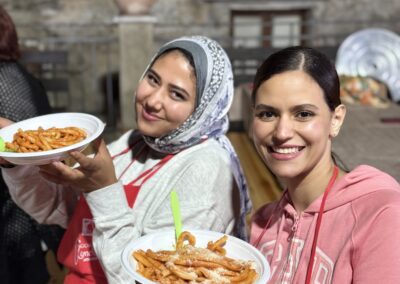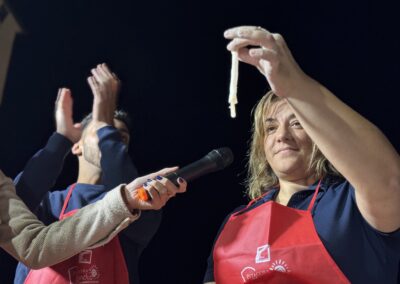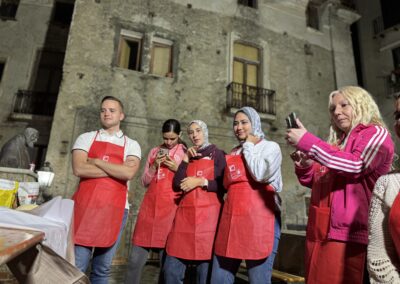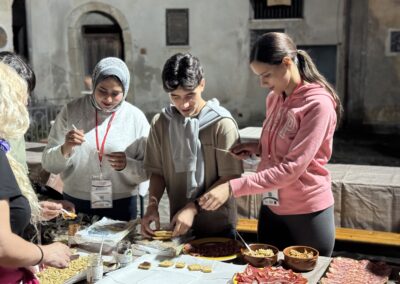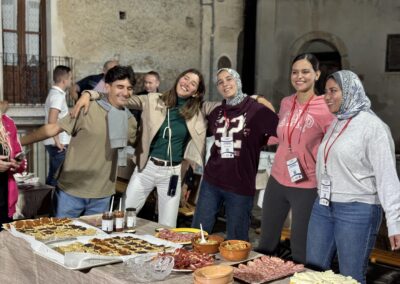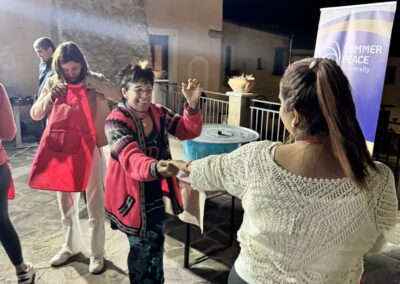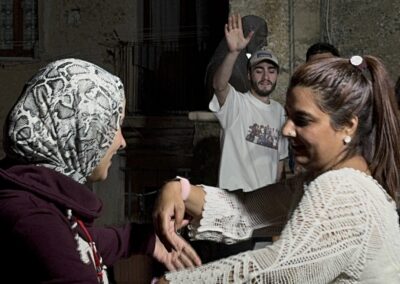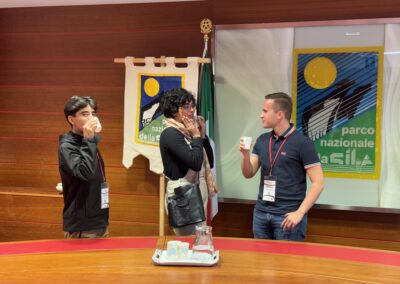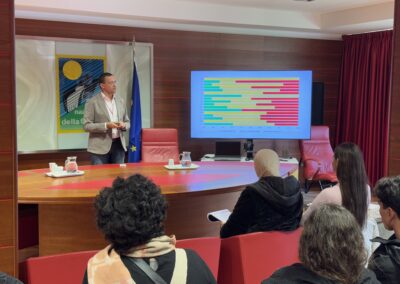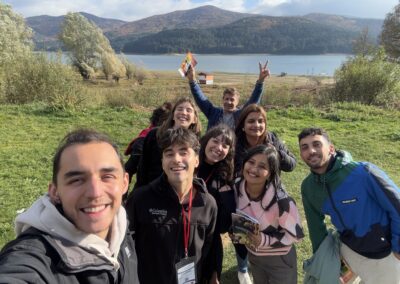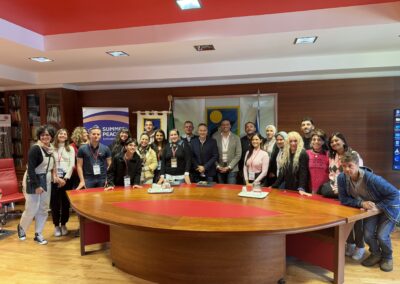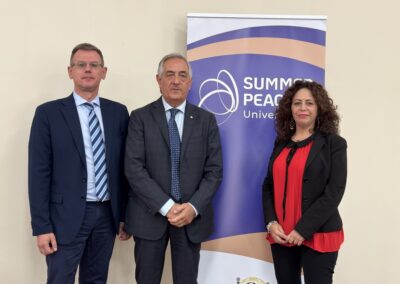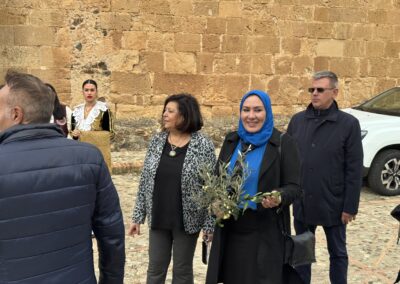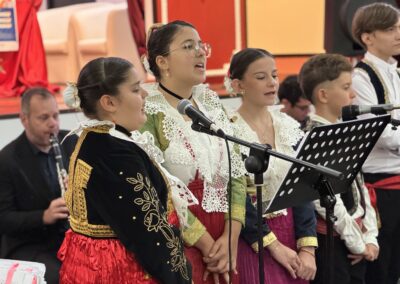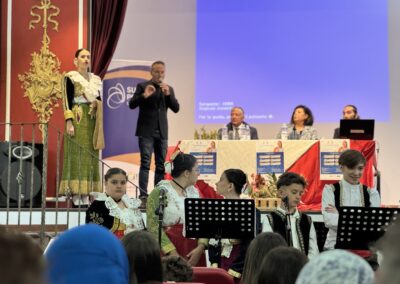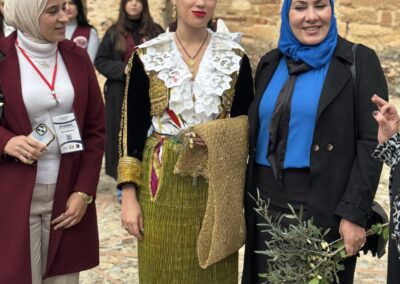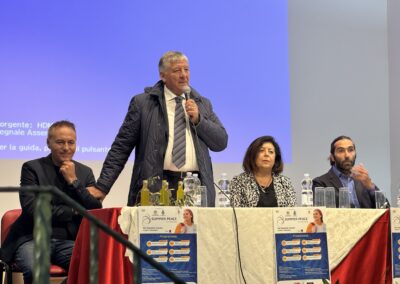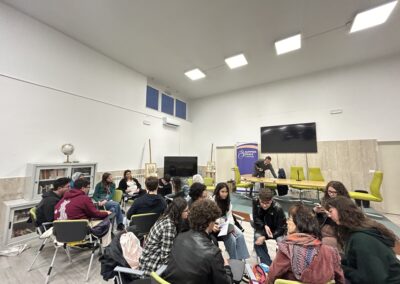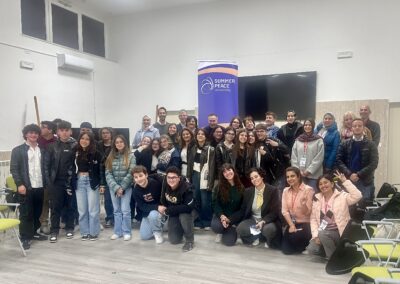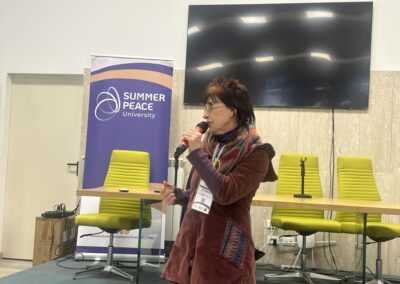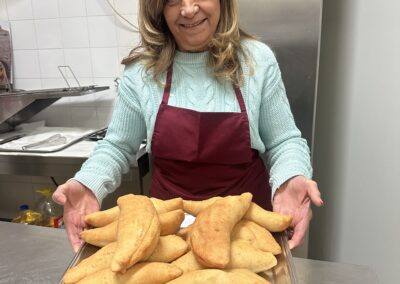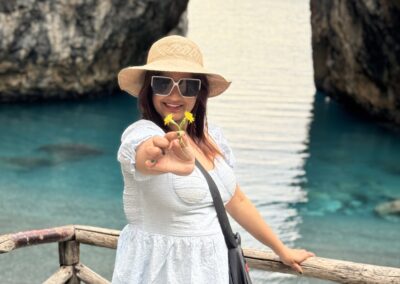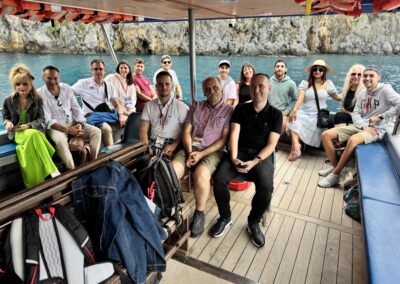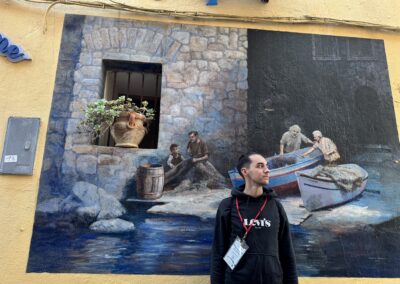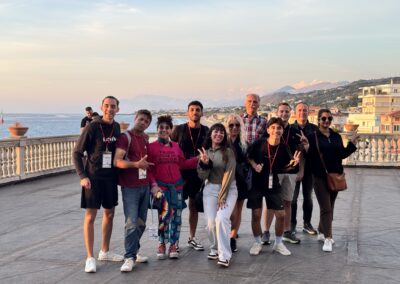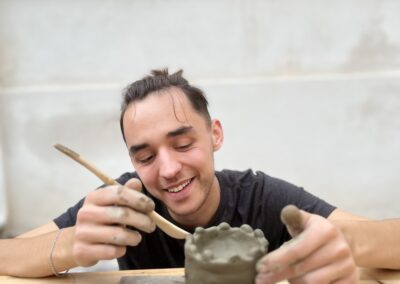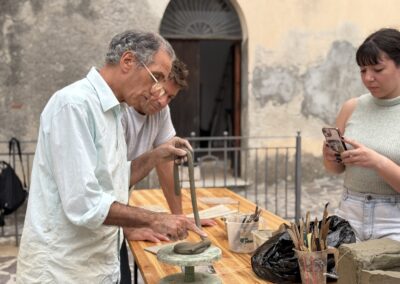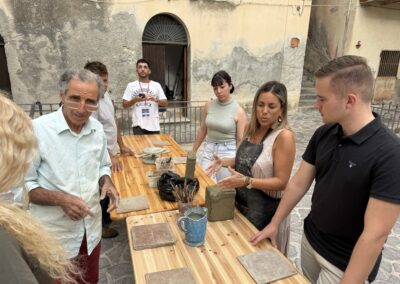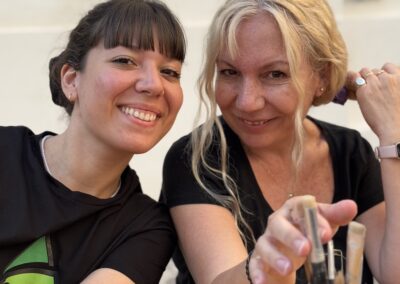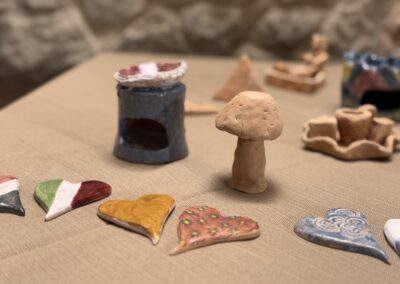Red Route
From Pasta to Unity
On Monday, October 28th, during the second week of activities at Summer Peace University, participants were introduced to the innovative “Red Route” concept. This program leverages all five human senses to create a unique and immersive culinary experience. The day centered on Italy’s iconic dish—pasta—and aimed to blend cultural education with creativity and hands-on participation.
For Summer Peace University, it was very important to give the participants an authentic “taste” of Italy—not only by engaging with its people but also by experiencing all of its nuances: academic, cultural, and, true to the Red Route, culinary.
The activity commenced in the afternoon, featuring a live demonstration of traditional pasta-making in the historic setting of Belvedere Marittimo, in front of the Museum of Ceramics. Participants from diverse countries, including Argentina, Egypt, Nepal, and Poland, observed the process of making pasta from scratch and then engaged individually in recreating it. The session provided a deeper understanding of pasta’s cultural and regional significance across Italy, from its variations to its role as a staple in Italian cuisine.
Complementing the culinary experience was an introduction to Southern Italy’s renowned red wines. Local vintages were paired with the handmade pasta, offering participants an authentic taste of Italy’s gastronomic heritage while enhancing their appreciation of flavor pairing and the art of Italian winemaking.
The event concluded with a lively cultural exchange in the town square. Students shared traditional songs and dances from their home countries, fostering a sense of unity and mutual appreciation. This integration of food, music, and dance highlighted the program’s goal of promoting cross-cultural understanding and collaboration through experiential learning.
Overall, the pasta-themed event was highly successful, enriching participants’ knowledge of Italian culinary traditions while strengthening interpersonal bonds among the international cohort. It exemplified the Red Route’s capacity to transform sensory experiences into meaningful cultural engagement.
Exploring Calabria’s Flavors
On Tuesday, November 5th, during the third week of Summer Peace University, participants embarked on another journey through the Red Route, the second culinary session focused on a cherished southern Italian delicacy—le crispelle.
For Summer Peace University, offering participants a genuine “taste” of Italy meant immersing them in the traditions of not only national but also regional cuisine. Le crispelle, a Calabrian specialty, was chosen for its significance as a dish deeply rooted in communal gatherings, street fairs, and celebrations. Its inclusion after the earlier pasta event seemed to be the natural choice, due to the dish’s unique importance at the regional level, reflecting Calabria’s distinct culinary heritage.
Participants learned that le crispelle consists of a simple yeast-based dough made from flour, water, and salt, which is allowed to rise before being shaped and deep-fried. They also discovered the dish’s versatility, with variations that include savory fillings such as anchovies or ricotta cheese, as well as sweet options featuring honey or sugar. Local experts shared how each Calabrian family or town often has its own version of the recipe, further emphasizing the region’s rich diversity.
The event was held in the very same courtyard in front of the ceramics museum, in the historical village of Belvedere Marittimo. This setting provided a tangible connection to the local culture and traditions. Participants actively engaged in preparing le crispelle, from kneading the dough to shaping and frying it, bringing a hands-on element that deepened their appreciation for this time-honored dish.
To complement the crispelle, participants enjoyed tastings of local liqueurs and aperitifs, further exploring Calabria’s distinctive flavors. This pairing offered an additional layer of sensory discovery, demonstrating the interplay between traditional dishes and regional beverages.
The evening concluded in same manner as the previous held event with a lively cultural exchange, where the students created a vibrant atmosphere of unity by talking passionately about different topics and engaging in group dances.
This Red Route session on le crispelle was an invaluable cultural experience. It not only celebrated Calabria’s culinary traditions but also showcased Italy´s diversity and above all its ability to bring people together through food. The experience exemplified the Red Route’s mission to use sensory immersion as a bridge to deeper cultural understanding. Having experienced what a great success the Red route turned out to be, we at Summer Peace University, are confident that it will likewise enrich the next edition in 2025.
Green Route
Sila National Park
The third week of Summer Peace University (SPU) continued its innovative Green Path initiative, combining immersive excursions with pressing themes of climate change, justice, and corruption. By bringing participants into Calabria’s natural and cultural landscapes, the program transcended traditional learning environments, fostering direct engagement with real-world challenges and historical heritage.
The week began with an excursion to the breathtaking Sila National Park, an ecologically rich region ideal for exploring the intersection of climate change and biodiversity. Guided by experts from GAL SILA and Dr. Ahmed Elshazly from Heliopolis University, participants delved into topics such as ecosystems, sustainable development principles, and the biosphere’s interconnectedness.
The serene setting allowed for reflection and dialogue, bridging theoretical concepts with tangible ecological systems. This hands-on approach underscored the Green Path’s mission: to transform environmental education into actionable insights. A minute of silence honoring victims of the recent Valencia floods highlighted the relevance of global solidarity in addressing climate crises.
Reggio di Calabria
Later in the week, participants journeyed to Reggio di Calabria, integrating themes of legality, history, and cultural preservation. The day began with a significant meeting at the Regional Council of Calabria, where students engaged directly with Pietro Molinaro, President of the Legality and Anti-‘Ndrangheta Commission. Discussions centered on the fight against organized crime, particularly the ‘Ndrangheta, emphasizing its global implications.
Through insightful analyses by officials like Fabrizia Arcuri and international perspectives led by the Academic Coordinator of the International Scientific Committee, Pavel Malyzhenkov, participants gained a nuanced understanding of transnational crime and legislative frameworks addressing corruption. These dialogues reinforced SPU’s focus on fostering global justice and social responsibility.
The visit concluded with a guided tour of the National Archaeological Museum of Reggio di Calabria (MArRC), led by Senator Tilde Minasi. Participants explored Calabria’s rich cultural legacy, from ancient Magna Graecia artifacts to prehistoric treasures, deepening their appreciation of the region’s historical significance.
The excursions exemplified how Summer Peace University approaches education, seamlessly integrating environmental and cultural exploration with global challenges. By immersing participants in Calabria’s natural beauty and historical depth, the Green route provided a dynamic platform for understanding sustainability, justice, and heritage in action.
The week’s activities fostered a profound connection between participants and the region, demonstrating how ecological preservation and cultural legacy can inspire solutions to contemporary global issues. This innovative model of experiential learning reinforced SPU’s mission to empower future leaders with the tools to drive meaningful change in their communities and beyond.
San Demetrio Corone
The fourth week of Summer Peace University (SPU), commencing on November 11th, continued to build on the Green Route initiative, offering participants a unique opportunity to immerse themselves in the cultural heritage and historical narratives of Calabria. This week’s focus was on migration, history, and cultural preservation, with excursions to San Demetrio Corone and San Marco Argentano.
The day began with a visit to San Demetrio Corone, a village historically connected to the Calabrian Albanian (Arbereshe) community. The participants were welcomed by the Istituto Omnicomprensivo, which showcased traditional folk songs and Albanian attire, emphasizing the community’s cultural resilience and deep-rooted identity.
This immersive experience blended cultural celebration with academic exploration. The group was introduced to the complex dynamics of global migration through a lecture by Prof. Gihan Mohamed. This session provided participants with a broader understanding of historical and contemporary migration trends, fostering insightful discussions about the socio-political factors influencing global mobility.
The day also featured a communal lunch, which encouraged cultural exchange and camaraderie among participants. Following the meal, the group visited St. Adrian’s Church, one of Italy’s oldest Eastern Rite churches, and local museums, which displayed a rich array of historical artifacts, including materials from the Risorgimento era. These visits highlighted the region’s complex history and the vital role of migration in shaping its cultural and political landscape.
San Marco Argentano
The next day, the Green Route took participants to the village of San Marco Argentano, where they engaged in an interactive peace-focused session at the Biblioteca Comunale Emanuele Conti. The session, held in collaboration with local high school students, facilitated a discussion on the core values of peace, resulting in the identification of key terms such as Respect, Love, Education, Responsibility, Independence, Power, and Rights. This collaborative brainstorming reinforced the importance of dialogue and mutual understanding in fostering peaceful coexistence.
In the afternoon, the group explored the Torre del Drogone, a Norman-era castle. Led by archaeologist Dr. Osvaldo Gaudio, participants gained insights into Calabria’s Norman heritage, deepening their understanding of the region’s historical context and its influence on contemporary identities.
The day concluded with a culinary experience, where participants learned to prepare Panzerotti, a local delicacy, under the guidance of master chef Gigino Chimenti. This hands-on activity not only connected participants to Calabria’s gastronomic traditions but also reinforced the theme of cultural exchange, as participants actively engaged in preserving and sharing local culinary knowledge.
These excursions exemplified the Green Route’s mission to integrate cultural immersion with global challenges. By exploring the histories and traditions of local communities, the program fostered a deeper understanding of migration, peace, and cultural heritage. The experiences in San Demetrio Corone and San Marco Argentano provided participants with valuable insights into the complexities of identity, migration, and the importance of peacebuilding through cultural dialogue.
The activities throughout the day highlighted the importance of shared experiences in fostering mutual respect and understanding. Through these enriching encounters, SPU participants not only learned about the history of Calabria but also reflected on the broader global challenges of migration and peace, reinforcing the university’s commitment to fostering global citizenship and promoting peace through cultural awareness and engagement.
Village Tour
During the first edition of Summer Peace University, we aimed to redefine traditional academic experiences by integrating classroom-based learning with immersive, nature-focused excursions. The Green route, introduced in the first week of the program, was designed to connect participants with Calabria’s rich natural and cultural heritage. This approach was centered around the emphasis of sustainability and experiential learning, offering participants a tangible understanding of sustainable development in action, beyond theoretical discussions within classroom walls.
The Green Path activities commenced on the inaugural day of SPU following the official welcome event, hosted by Program Manager Dr. Salvatore La Porta. Participants explored the historical village of Belvedere Marittimo, a picturesque gem of Calabria. Each alleyway and stone offered a glimpse into the region’s deep history, captivating students with the village’s timeless charm. This activity proved to be a good stepping stone for future excursions and thus set the stage for SPU’s commitment to integrating academic learning with cultural and environmental appreciation.
Praia a mare
The first full-day excursion, following the morning lecture, took participants to Praia a Mare, a seaside town renowned for its breathtaking natural and cultural landmarks. Accompanied by SPU staff, the group explored notable attractions, including the majestic Isola di Dino and the Madonna della Grotta Sanctuary, uniquely nestled within a cave. Participants also enjoyed a refreshing swim at the scenic cove of San Nicola Arcella, surrounded by dramatic rock formations.
This excursion allowed participants to experience Calabria’s ecological diversity firsthand, blending elements of theoretical knowledge with real-world exploration. The day highlighted the importance of engaging with the environment as a means of appreciating and preserving its beauty.
The first exposure to the Green route activities were met with enthusiasm from both students and faculty. Participants appreciated the innovative approach of combining academic learning with cultural and environmental immersion. The excursions encouraged an active engagement with sustainability principles, fostering a deeper appreciation for the natural world.
Upon returning to Belvedere Marittimo, the students had the opportunity to do grocery shopping to prepare for the weeks ahead, ensuring and providing a balance between academic and personal activities.
Diamante village tour
The seaside village of Diamante, famed for its vibrant murals and cultural heritage, was the destination for the October 29th excursion of Summer Peace University. Accompanied by SPU staff, participants had the opportunity to explore this artistic gem of Calabria, where history, creativity, and community pride converge.
Diamante’s murals, painted by artists from around the world, serve as a dynamic open-air gallery, showcasing themes ranging from local folklore to global issues such as social justice and environmental conservation. Strolling through the streets, participants were captivated by the colorful depictions that transformed the village into a living canvas. These works of art spurred meaningful discussions about the role of creativity in fostering community identity and addressing societal challenges.
The excursion also celebrated Diamante’s connection to Calabria’s culinary heritage, particularly its renown as the “Peperoncino Capital.” Students learned about the village’s long-standing tradition of cultivating and celebrating chili peppers, which are not only integral to local cuisine but also symbolize vitality and passion in Calabrian culture. The group explored the Museo del Peperoncino, where they discovered the history and significance of this fiery ingredient, alongside its cultural associations in both art and gastronomy.
Other highlights included a leisurely visit to Diamante’s picturesque promenade, offering stunning views of the Tyrrhenian Sea. The serene coastal ambiance provided participants with an opportunity to reflect on the integration of natural beauty and cultural heritage within the Green Route’s framework.
The students and faculty expressed their admiration for the unique combination of art, culture, and gastronomy that Diamante offered. Many noted that the murals were not only visually striking but also intellectually stimulating, serving as a testament to the village’s progressive spirit. This excursion reinforced the SPU’s mission to bridge academic concepts with real-world experiences, emphasizing the power of creativity and tradition in promoting sustainable development and intercultural dialogue.
Upon their return to Belvedere Marittimo, participants shared their reflections on the day, expressing gratitude for the opportunity to engage so directly with Calabria’s artistic and cultural legacy. This excursion to Diamante exemplified the essence of the Green Route, combining environmental appreciation, cultural enrichment, and community engagement into a memorable and impactful learning experience.
Yellow Route
Molding memories
On October 24th, the participants of Summer Peace University embarked on the Yellow Route, an initiative designed to combine art, craftsmanship, and a deeper connection to the environment. This hands-on experience aimed to engage participants in creating ceramic objects, blending cultural expression with an appreciation for natural resources.
The first session took place in the historical village of Belvedere Marittimo, at a local ceramic workshop. Under the guidance of a skilled artisan Damiano, students learned the foundational techniques of traditional ceramic craft using clay sourced from Calabria’s soil. The activity offered participants an opportunity to express their cultural identities, with many creating objects reflective of their home countries. A notable example was the Egyptian participants, who skillfully shaped intricate clay pyramids, resembling those of Giza very accurately. This physical interaction with Calabrian clay was intended to deepen the students’ connection to the region’s natural environment, highlighting the artistic potential of the earth’s resources.
From Clay to Canvas
A follow-up session on November 6th expanded on the earlier work by introducing students to the painting process. They focused on heart-shaped ceramic forms, carefully prepared by washing them with limited water—emphasizing the importance of resource moderation. Participants then used their creativity to paint the objects in their favorite colors, all while being informed that the final results, due to the baking process, would transform into different hues. This element of surprise symbolized embracing the unknown and valuing unpredictability in the creative process.
The inclusion of the Yellow Route in the four-week learning program was vital to achieving the university’s mission of fostering a holistic educational experience. By combining artistic expression with craftsmanship, the route offered participants a chance to engage with Calabria’s cultural and natural heritage in a tangible way. The process of creating and painting ceramics symbolized the importance of patience, precision, and resourcefulness, while also encouraging creativity and self-expression.
Moreover, the Yellow Route cultivated an appreciation for the interconnectedness of art, nature, and community. The use of local materials not only celebrated Calabria’s unique resources but also fostered an environmental consciousness among the participants. The program allowed students from diverse backgrounds to share their cultural identities through art, creating a platform for cross-cultural dialogue and mutual understanding.
In essence, the Yellow Route was an invaluable component of Summer Peace University, enriching participants’ experiences through a meaningful connection to the environment and the universal language of art and craftsmanship. It exemplified the transformative potential of combining creativity with cultural and ecological appreciation.

